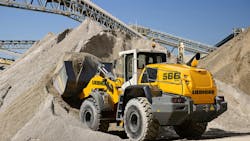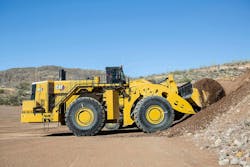There are around a dozen manufacturers that make wheel loaders over 200 horsepower, but sizes and capabilities in this higher production category vary.
Here is how to determine the size of the loader your operation needs.
Determine the lift capacity for the wheel loader
"When calculating the size of the wheel loader needed, it's important to start with the material going into the bucket,” said Bill Zak, wheel loader product manager for Develon. “When I work with sales specialists, I encourage them to ask customers what they’re doing with the machine. The next question is what is the material density? How heavy is the material the customer is moving?
Read operator evaluations of wheel loaders, such as Pro operators test Volvo L180H wheel loader
“The sales specialist starts by discussing the lift capacity of a machine in a straight position,” Zak said. “For example, let’s say it’s 45,000 pounds. When we articulate the machine, the lift capacity decreases to approximately 40,000 pounds. When the operator raises the lift arms and bucket as high as they will go, we’ll take the articulated tipping load and cut it in half. That’s what we call a safe operating load.
“In this example, the safe operating load is 20,000 pounds,” Zak said. “The sales specialist needs to ask the customer how much the material weighs. That will dictate the size of the bucket and the wheel loader model.”
Caterpillar has published a handy guide for state, county, and municipal users on configuring wheel loaders. It focuses on full-turn static tipping load (FTSTL) and lift height:
- The FTSTL defines the amount of bucket material weight it will take for the machine to tip when the loader arms are level and the machine is fully articulated.
- The rated load for a bucket is 50% of the FTSTL and can be up to 80% of the FTSTL for a set of forks. It’s an essential guide as to how much the machine can safely lift while in operation. Depending on the ground conditions, you may be able to safely operate the machine at a reduced factor; however, using rated load as a guide is a good starting point.
- For example, if you need to be able to lift 6,000 pounds of material in the bucket, you want to select a machine with a 12,000-pound FTSTL and 6,000-pound rated bucket capacity.
- To properly size the bucket on your wheel loader, a simple rule of thumb is to use the rated load (FTSTL/2) divided by the material density. This will give you your optimum bucket size.
- If your application requires loading a truck or hopper with tall height, you may want to consider a machine with a high-lift linkage option or purchasing a rollout bucket to help increase dump height.
A machine with higher horsepower doesn’t translate to a higher FTSTL and vice versa. If the loader is properly designed, horsepower will never translate into higher FTSTL.
Attachments for wheel loaders
If an application requires operation of hydromechanical attachments, such as brooms, snow blowers, power box rakes, or cold planers, it is important to select a machine with an adequate amount of hydraulic horsepower necessary to operate that attachment at maximum performance. Features such as high-flow or four-valve hydraulics may be needed to run specialty tools, Cat said.
See what manufacturers are offering in the 200+ horsepower category of wheel loaders.
About the Author
Frank Raczon
Raczon’s writing career spans nearly 25 years, including magazine publishing and public relations work with some of the industry’s major equipment manufacturers. He has won numerous awards in his career, including nods from the Construction Writers Association, the Association of Equipment Manufacturers, and BtoB magazine. He is responsible for the magazine's Buying Files.



